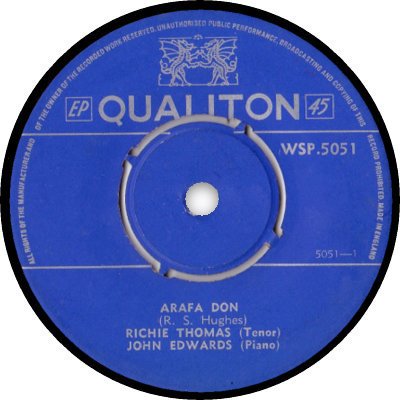
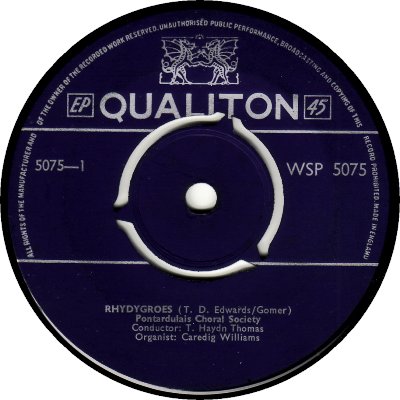
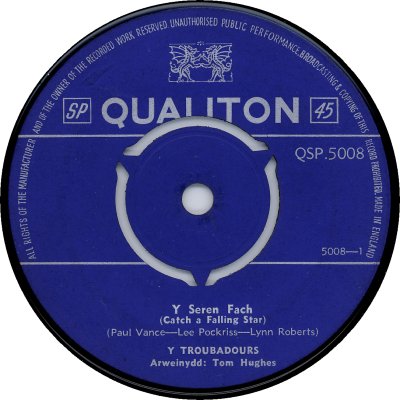
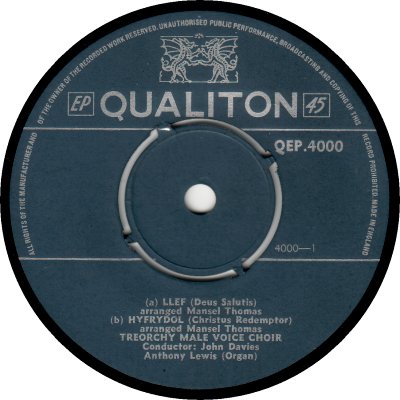
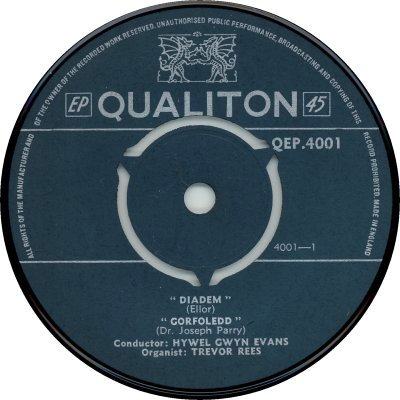


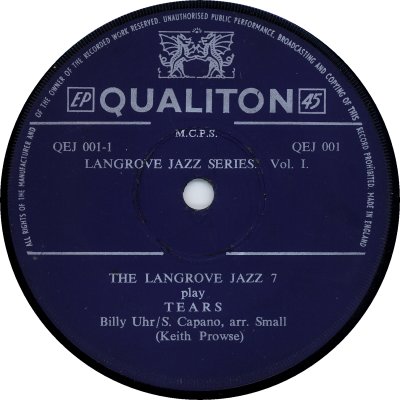
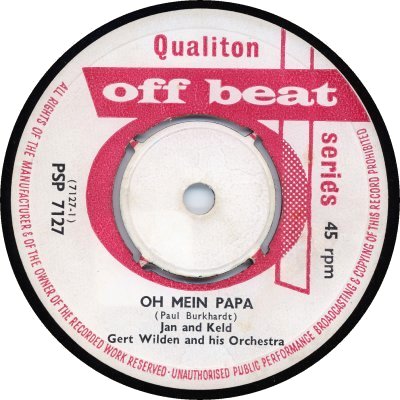
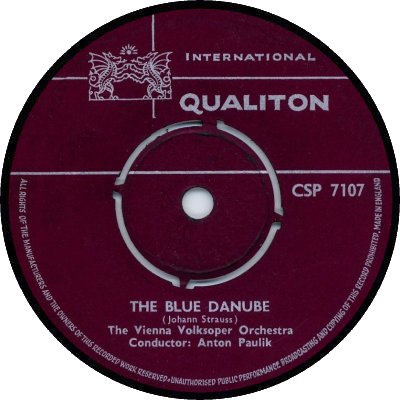
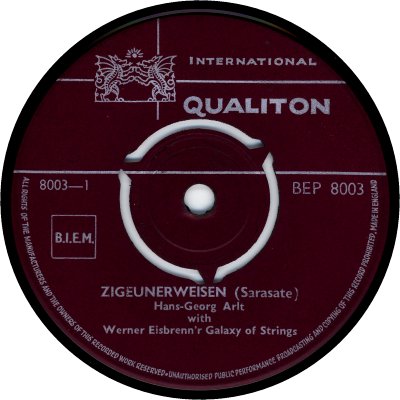
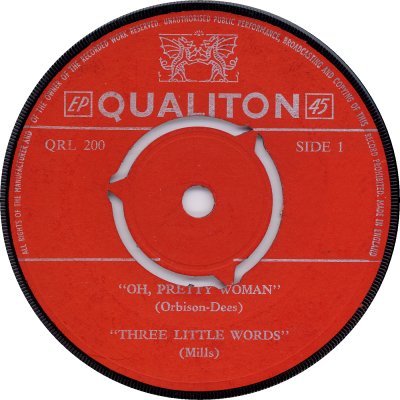
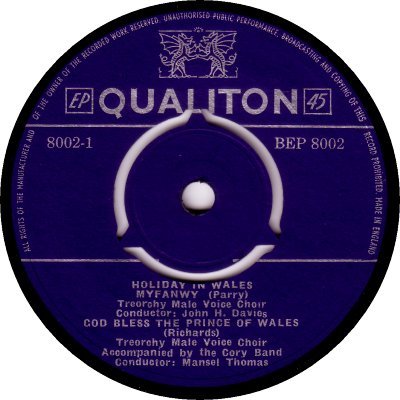

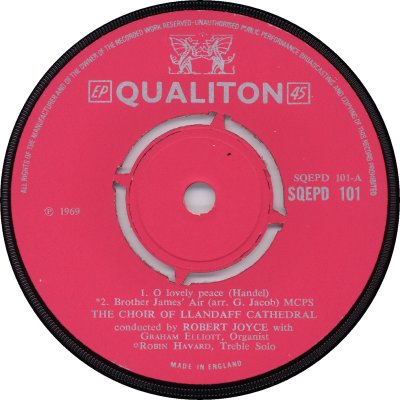
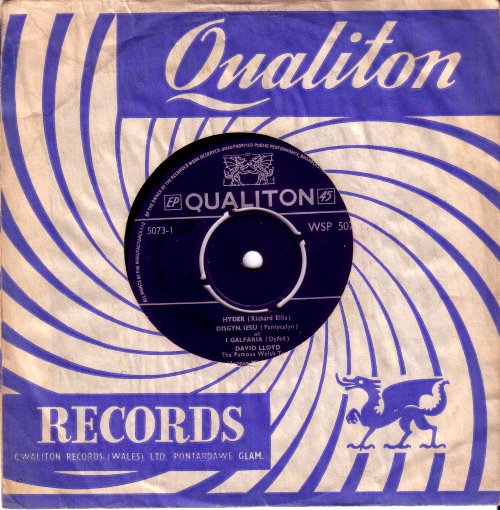
The mainly Welsh-language Qualiton label was owned by Cwaliton Records (Wales), from Pontardawe, near Neath - I wonder why the label itself wasn't called 'Cwaliton'; it would have avoided confusion with the Hungarian label. Be that as it may; Qualiton was founded by John Edwards in 1954, and its early issues were 78 rpm ones. From its inception until Edwards's death in 1966 Qualiton concentrated on fairly serious material, as befitted his standing as the man behind the Guild for the Promotion of Welsh Music. In the main it offered songs which would appeal to the older generation: hymns, sacred songs, popular songs from bygone days, and so forth, sung by Male Voice Choirs, Choral Societies and solo singers. In 1959, however, it began to diversify. It licensed several recordings from abroad and issued them on a sub-label, 'Qualiton International' (10, 11), and in addition it signed some overseas artists and put their records out on an other new label, 'Qualiton Off Beat' (9). In its issue of the 30th of January 1960 the music paper 'Disc' contained an article about Qualiton's venture into the Pop field. A spokesman for the firm was quoted as saying that it had had to look abroad for Pop artists because there were none in Wales whom it could launch on discs, and most of those in England were already under contract. Sales of Jlse Werner's 'Baciare' b/w 'Loving Is A Way Of Living' (PSP-7125; 1959) had been sufficiently good for her to be contracted to come to Britain and make personal appearances, and negotiations with at least one other artist were in hand. The hope was that these Continental performers would enable Qualiton to 'provide serious competition' for 'the giants of the business' and that sales would subsidize its Welsh output. Sadly the rarity of most Off Beat singles suggests that those hopes were disappointed. Qualiton International seems to have expired in 1960 and the Off Beat label didn't survive long into 1961.
According to 'Record Retailer' of the 14th of August 1968 John Edwards left Qualiton in 1962 to start his own Teldisc (q.v.) company, but I have yet to find confirmation of his departure. It may well be that instead of leaving Qualiton he set up Teldisc as a 'popular music' stable-mate to it - the fact that when he died his wife Olwen took over the company suggests that he had still been very much involved with it till the end. Under Olwen Edwards more Pop-flavoured material began to appear on Qualiton, and in November 1967 the company issued the first Welsh-language Rock single, 'Maes "B'" b/w 'Beth Sy'n Dod Rhyngom Ni' by Y Blew (QSP-7001); it is very collectable nowadays. Qualiton was sold to Decca not long after that, and Decca re-formed it as Qualiton Records (1968) Ltd. 'RR' of the 14th of June 1969 reported that Decca would be launching Qualiton under its own logo the following month. During the '50s and '60s Qualiton had issued more than 100 7" records, the majority being EPs, but under its new owner it concentrated on LPs. Several EPs were reissued, however, probably in 1969, but one new EP, the Llandaff Cathedral Choir's 'O Lovely Peace', was definitely released in the '70s - in March 1970, to be more exact, despite the '1969' on the label (15) - entitling Qualiton to a page on this site. The EP was available in mono (QEPD-101) or stereo (SQEPD-101). As part of the Decca family Qualiton put out a reasonable number of albums, both of repackaged old material and new recordings, but it seems not to have survived past 1978.
Qualiton's early records were pressed in England, but in 1958 it opened its own pressing plant. I haven't been able to inspect enough of the company's EPs and singles to be certain but it looks as though some of its in-house pressings had narrow four-pronged dinking perforations or wider three-pronged perforations with no anti-slip ridges. Records with anti-slip ridges and wide three-pronged perforations appear to be Philips pressings. American Trade paper 'Billboard' of the 3rd of June 1967 reported that Spot Productions of London had taken a controlling interest in the plant and had formed a new company, Spot Pressings, to run it. According to the article, at that time the plant had a staff of 30; changes and reorganization were to take place but it was expected that the Qualiton label would continue. Before long, however, Qualiton Records was sold to Decca; while the pressing plant was closed and the equipment moved to London.
Several different numerical series were used. Singles were mainly numbered in the WSP-5050s (1, 2), but there was also a QSP-5000 series which seems to have been for material which was either in English or was slightly more 'Pop' orientated than Qualiton's usual output (3). Off Beat singles were numbered in the PSP-7100s, while International singles came in a CSP-7100 series - the 7100 numbers may have been shared by both. The main EP series was a QEP-4000 one; the was also a BEP-8000 one, which was eventually used for International records, and there were also two very short-lived series: QEJ-100 for Jazz records, the 'Langrove Jazz Series' (7), and QRL-200, which was apparently for cover versions of English language Pop hits - I've only ever seen one example of each. No artist was credited on the QRL-200 EP, which makes me wonder if it was intended to be in competition with other anonymous cover-sersion EPs of the time. The originals of the songs on it were all hits in 1964. The only new EP to be released by Decca was the sole entry in an (S)QEPD-100 series.
As for the labels, one basic design served throughout but it came in several different colours. Early WSP-5050 singles had mid-blue labels (1); the colour turned dark blue (2) towards the end of the 1950s with WSP-5058. EP labels started out grey-green (4, 5) before adopting the dark blue colour (6) around QEP-4020. Re-pressings meant that some popular records can be found in both colours. The final few EPs had black / dark grey labels (7). Decca-era Qualitons retained the old label design more or less, but the labels were coloured pink instead of blue or blue-green and the parallel horizontal lines disappeared (14, 15). Some popular records were re-pressed by Decca and re-promoted, and as a result they can be found with both the old and new labels, as shown in scans 13 (older) and 14 (new) above - the oldest pressings of that EP had grey-green labels. The Internationals had plum coloured labels (10, 11), and the QRL-200 orange ones (12). As stated above, Off Beat had a design of its own (9). For some reason Qualiton's labels seem to always have had 'Made in England' on them, despite the fact that a lot of them were pressed in Wales. In addition the singles usually had 'EP' in a box to the left of the logo, even though they weren't expended play; only a small minority have an 'S' there instead, the first scan above showing an example. The discography below lists those EPs which were listed in the 1978 edition of 'Music Master' as having been available through Decca. Definite re-pressings with pink labels are marked with an asterisk, while the existence of pink-labelled versions of the others remains to be confirmed - any confirmations would be welcome.
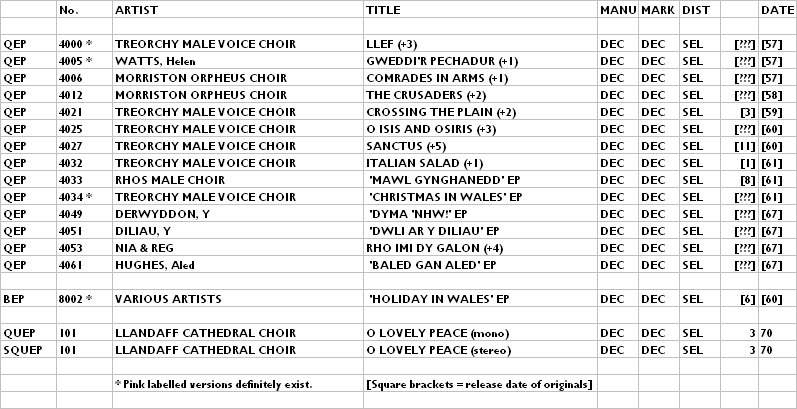


Copyright 2006 Robert Lyons.

